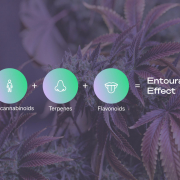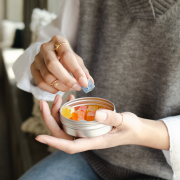Dialing in the right dosage of THC can make the difference between a perfect high and straight up not having a good time. Too little can leave you wanting more and too much can put you on the floor, so you want to find that Goldilocks dosage that is just right. Figuring out that perfect dosage involves a lot of factors, from your own biology to the way you like to ingest your THC. We have all the information you need here at Central Iowa Vapors to make sure you get it right every time.
Finding the Ideal Dose
When it comes to perfect THC dosing, no two people are identical. Because THC affects a person through interaction with their uniquely tuned endocannabinoid system, a variety of biological factors can impact the strength of the dose. These factors include:
- Body weight
- Tolerance
- Metabolism
- Gender
- General health
- Gastrointestinal factors
People with more body mass can often tolerate a higher dosage of THC and experienced users sometimes need higher dosages to achieve the desired high. A high-powered metabolism can increase the onset of effects as well as speed up the timeframe in which the body processes THC and returns to its normal state. Because of an array of organic differences, THC affects biological females differently than it does males, including a higher initial sensitivity for females, a quicker development of tolerance for females, and a higher susceptibility to “the munchies” in males. You can read more about the gender differences in THC usage here. When using THC medically, the bioavailability of THC can be altered by the disease you’re hoping to treat the symptoms of, so sometimes a higher dose may be necessary to experience the desired therapeutic effect.
Methods of Dosing THC
THC Flower
Dosing with flower can be tricky because of the variables involved. Whether you’re smoking a joint, bowl, or bong can all impact the onset of effects. The strain of flower and concentration of THC in the flower will also have an impact on the high. When smoking flower, you’re likely to feel the effects of the THC very quickly, within 10 to 20 minutes. The effects can last for between 3 and 6 hours. Make sure when smoking flower that you have information about both the strain and concentration so you can dial in the dose that’s perfect for you. Buying from a reputable source like Central Iowa Vapors will ensure that you know that you’re getting quality flower that is lab-tested and clearly labeled.
Vaporized THC
Vaporizers are popular for the discretion they provide and the smoothness of the hit. THC vape can be purchased in a variety of forms, including disposable vapes, cartridges, and reloadable juice. There are even vaporizers that can be loaded with flower. The concentration and voltage used can affect the high you experience. Like flower, vaping THC is difficult to measure the exact dosage being received with each puff. The effects of THC when vaping are likely to set in quickly, between 10 and 20 minutes and can also last between 3 and 6 hours. Because of how rapidly the experience sets in, with flower and vape, it’s smart to start small and see how you feel and then upping the dose if necessary.
THC Dabs and Concentrates
THC dabs and concentrates have the most potent levels of THC. The benefits are that the THC reaches your system faster, more efficiently, and with more potency. The downside is the potential for accidentally getting too high is a little steeper than with smoking or vaping. Still, you shouldn’t let that deter you from giving concentrates a try. If you want to know more about the types of dabs and concentrates available to you, you can read all about them here.
THC Edibles
THC edibles are incredibly popular for a variety of reasons. They’re smokeless, discreet, delicious, and when purchased from a reputable source they have clear THC doses. Edibles can take up to an hour before the effects fully set in, and those effects can last between 3 and 6 hours. However, because of the much longer onset of symptoms, edibles also carry one of bigger risks of accidentally taking too high of a dose. We’ve all heard a story about someone who took an edible, didn’t feel anything, took some more, and ultimately ended up glued to their couch. Understanding how many milligrams to start with, what the desired effects are, and how long to wait before having more are all important in getting that perfect edible high.
How Many MGs of THC Should I eat?
When buying edibles, dosages typically come in 5 mg or 10 mg amounts, particularly gummies. Other types of edibles, like chocolate bars or baked goods may come in much larger dosages that are intended to be broken or cut apart, so make sure you know the dosage you’re dealing with before diving in face first. Starting with a gummy or something you can easily parse out the dosage of is a great way to get started with edibles. Here’s a chart of dosages and what you can expect from them:
1 to 2.5 milligrams
- Effects: Mild therapeutic effects, very low psychoactive effects. Gentle pain relief, relief of anxiety, increased creativity, soothing relaxation.
- Who the dose is for: First time users who are dipping their toe into THC edibles or those looking for a micro dose.
5 milligrams
- Effects: More pronounced relief of pain and anxiety, euphoria, could impair coordination or alter perception, mild sedation
- Who the dose is for: Recreational use for beginners or those with known lower tolerance, individuals looking to use THC as a sleep aid.
10 milligrams
- Effects: Strong psychoactive effects, euphoria, sedation, impaired coordination, altered perception
- Who the dose is for: Experienced THC users, recreational consumers, medicinal users, could induce unwanted effects in unfamiliar users.
20 milligrams
- Effects: Very powerful euphoric effects, high likelihood of impairment, not recommended for inexperienced users
- Who the dose is for: THC users who have developed a significant tolerance or patients with gastrointestinal issues that affect THC absorption.
25 milligrams or higher
- Effects: Serious impairment, possibility of negative side effects including nausea, dizziness, paranoia, or accelerated heart rate
- Who the dose is for: High-tolerance, daily THC users with experience in using higher doses, patients living with high-pain, cancer, inflammatory disorders, or other conditions that necessitate high doses.
Advice For Taking Edibles for the First Time
When taking edibles for the first time, the best advice is to start low and go slow. Begin with a low dosage and wait for an hour or an hour and a half to evaluate how you feel. If you’re comfortable with the effects or looking for a more pronounced experience, you can step it up from there. Other pieces of advice for first time edible users include:
- Make sure you are buying from a reputable source that uses quality ingredients that are laboratory tested. At Central Iowa Vapors, we only sell the highest quality products and lab results for all our products can be found online.
- Make sure the dosage is clearly labeled so you can make a smart and safe dosage choice when consuming the edibles, you purchase.
- Start with between 2.5 and 5 milligrams depending on your size and desired effects.
If you’re ready to give edibles, or any other kind of THC a try, this guide will put you in the right track so that you’re guaranteed to have a good time. Central Iowa Vapors has everything you need, from dabs, to edibles. So, what are you waiting for?











